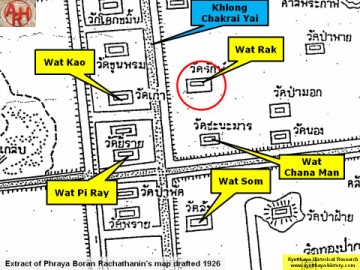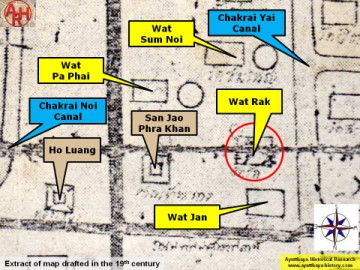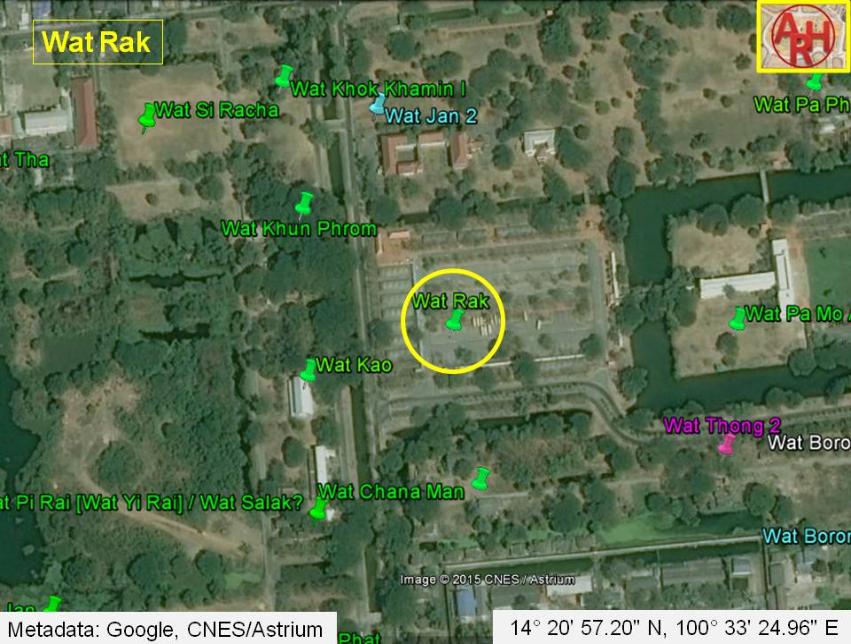| WAT RAK (วัดรัก) |
| Wat Rak or the Monastery of the Crown Flower was situated on Ayutthaya's city island in the Historical Park in Pratu Chai Sub-district. The temple was located on the east bank of Khlong Chakrai Yai, called Khlong Tho in its northern stretch. On its south stood Wat Chana Man (no traces anymore); opposite Khlong Chakrai were Wat Kao (no traces anymore) and Wat Khun Phrom. In the east stood Wat Pa Mo (no traces anymore), the name at par with Khlong Pa Mo, a canal running just south of the temple, being an extension of Khlong Tha Phra. There are no traces of foundations or brick work at ground level and the temple is classified as disappeared. The site is mentioned on Phraya Boran Rachathanin's map drafted in 1926 and on a mid-19th century map. The position of the temple matches both maps. Historical data about the monastery and its construction is unknown. The monastery was likely named after the Calotropis Gigantea or Crown flower, a species of Calotropis native to Cambodia, Indonesia, Malaysia, Philippines, Thailand, Sri Lanka, India and China. It is a large shrub growing to 4 m tall. Its flowers are strung into garlands to be worn around the necks of criminals on their way to the place of execution. In Thailand the Rak tree grows wild in deserted dry places. Its trunk and branches have a milky sap and its flowers are used for floral pieces which are to be seen usually at cremations. Today it is the fashion for a bride and groom to wear a garland of these flowers, for the name "rak" means "love" in Thai. [1] |

| Text & maps by Tricky Vandenberg - October 2009 Reviewed July 2018 |
| (Detail of Phraya Boran Rachathanin's map - Anno 1926) |


| (Detail of a 19th century map - map is orientated S-N) |

| (Detail of a 1993 Fine Arts Department map - Courtesy Khun Supot Prommanot, Director of the 3th Regional Office of Fine Arts) |


| (Calotropis Gigantea) |
| John Bowring, the 4th Governor of Hong Kong and on a trade visit to Siam in 1855 had though another explanation: "The tree called rak by the Siamese is a species of banana, and furnishes the beautiful varnish so much valued in the lacquer-ware of China. Incisions are made in the bark, from whence exudes a thick, viscid, dirty-white gum, which is passed through a cloth, and put into jars of water, in which it is preserved from drying by contact with the air. This varnish is so caustic, that not only does it burn and ulcerate the skin, but its vapours produce inflammation of the eyes, and pustules on the face. When exposed to the air, it becomes first brown, and then intensely black. It is used for book-covers, baskets, furniture, and especially for gilt idols. It is neither affected by sun nor rain. Pallegoix expresses surprise that it has not been employed in Europe as a protection for gilded works, which so soon perish when exposed to the fluctuations of the seasons." [2] Wat Rak must have been approximately located in geographical coordinates: 14° 20' 57.20" N, 100° 33' 24.96" E (under the parking lot of the old Provincial Hall). References: [1] Some Siamese Superstitions about Trees and Plants - Phya Anuman Rajadhon - JSS Vol 49.1 - 1961 - page 58. [2] Bowring, John (1857) - The kingdom and people of Siam; with a narrative of the mission to that country in 1855 - Volume I - London: John W. Parker and son, West Strand - page 207. |